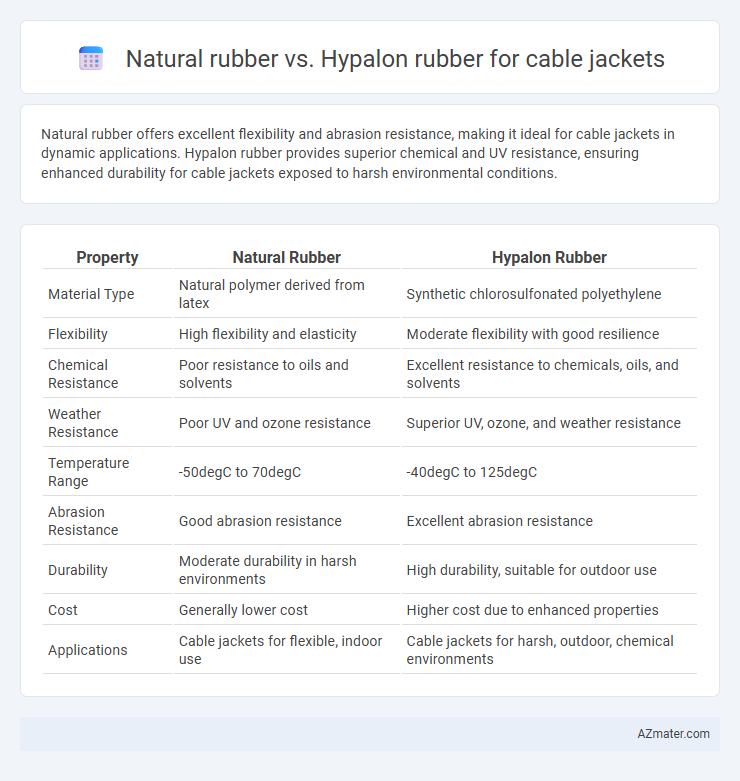Natural rubber offers excellent flexibility and abrasion resistance, making it ideal for cable jackets in dynamic applications. Hypalon rubber provides superior chemical and UV resistance, ensuring enhanced durability for cable jackets exposed to harsh environmental conditions.
Table of Comparison
| Property | Natural Rubber | Hypalon Rubber |
|---|---|---|
| Material Type | Natural polymer derived from latex | Synthetic chlorosulfonated polyethylene |
| Flexibility | High flexibility and elasticity | Moderate flexibility with good resilience |
| Chemical Resistance | Poor resistance to oils and solvents | Excellent resistance to chemicals, oils, and solvents |
| Weather Resistance | Poor UV and ozone resistance | Superior UV, ozone, and weather resistance |
| Temperature Range | -50degC to 70degC | -40degC to 125degC |
| Abrasion Resistance | Good abrasion resistance | Excellent abrasion resistance |
| Durability | Moderate durability in harsh environments | High durability, suitable for outdoor use |
| Cost | Generally lower cost | Higher cost due to enhanced properties |
| Applications | Cable jackets for flexible, indoor use | Cable jackets for harsh, outdoor, chemical environments |
Introduction to Cable Jacket Materials
Natural rubber offers excellent elasticity, resilience, and abrasion resistance, making it a cost-effective choice for cable jackets in low to moderate industrial applications. Hypalon rubber, a chlorosulfonated polyethylene, provides superior chemical, UV, and weather resistance, ensuring exceptional durability in harsh environments and outdoor installations. Selecting between natural rubber and Hypalon depends on the specific performance requirements including environmental exposure, mechanical stress, and expected cable lifespan.
Overview of Natural Rubber
Natural rubber, derived from the latex of Hevea brasiliensis trees, offers excellent elasticity, resilience, and abrasion resistance, making it ideal for flexible cable jackets. Its superior tensile strength and good insulation properties ensure reliable protection against mechanical stress and environmental factors in cable applications. Natural rubber's biodegradability and sustainability also contribute to its preference in eco-friendly cable jacket manufacturing.
Overview of Hypalon Rubber
Hypalon rubber, a chlorosulfonated polyethylene (CSM) synthetic elastomer, offers superior chemical resistance, UV stability, and weatherability compared to natural rubber, making it ideal for cable jackets in harsh environments. Its exceptional resistance to oils, acids, and oxidation ensures long-lasting performance in industrial applications where durability is critical. Hypalon's robust insulating properties and flexibility under extreme temperatures contribute to enhanced cable protection and reliability.
Key Physical Properties Comparison
Natural rubber offers excellent elasticity, high tensile strength, and superior abrasion resistance, making it highly flexible and durable for cable jackets exposed to dynamic stress. Hypalon rubber, known for its outstanding chemical resistance, UV stability, and weatherability, excels in harsh environmental conditions and prolonged outdoor applications. While natural rubber provides superior mechanical performance, Hypalon's resistance to ozone, chemicals, and aging makes it ideal for cables requiring long-term resilience in aggressive environments.
Chemical Resistance: Natural Rubber vs Hypalon
Hypalon rubber offers superior chemical resistance compared to natural rubber, making it more suitable for cable jackets exposed to harsh industrial chemicals, oils, and solvents. Natural rubber tends to degrade when in contact with ozone, acids, and alkalis, limiting its use in chemically aggressive environments. Hypalon's chlorosulfonated polyethylene structure provides enhanced durability and resistance to a wider range of chemicals, ensuring longer cable life in demanding applications.
Weathering and UV Resistance
Natural rubber offers excellent elasticity and abrasion resistance but exhibits poor weathering and UV resistance, leading to degradation and cracking when exposed to prolonged sunlight. Hypalon rubber, a chlorosulfonated polyethylene, provides superior weathering and UV resistance, maintaining flexibility and structural integrity in harsh outdoor environments. This makes Hypalon a preferred cable jacket material for applications requiring long-term durability against environmental factors.
Flexibility and Mechanical Strength
Natural rubber offers superior flexibility in cable jackets, providing excellent elongation and resilience under repeated bending, which is essential for dynamic applications. Hypalon rubber, known for its outstanding mechanical strength, exhibits high tensile strength and resistance to abrasion, chemical exposure, and harsh environmental conditions, making it ideal for rugged cable insulation. When balancing flexibility and mechanical durability, natural rubber excels in pliability, while Hypalon delivers enhanced toughness and long-term durability.
Cost Factors and Availability
Natural rubber offers cost-effective pricing and abundant availability due to its renewable sources and widespread production, making it a budget-friendly choice for cable jackets. Hypalon rubber, a synthetic elastomer, typically incurs higher costs stemming from complex manufacturing processes and limited suppliers, which can impact project budgets. Availability of Hypalon is more restricted compared to natural rubber, influencing procurement timelines and overall project feasibility.
Typical Applications for Each Material
Natural rubber is commonly used in flexible cable jackets for applications requiring excellent elasticity and abrasion resistance, such as portable power cords, extension cables, and outdoor equipment. Hypalon rubber, known for its superior chemical and weather resistance, is typically employed in industrial cables exposed to harsh environments, including chemical plants, marine settings, and underground installations. Both materials offer specific advantages tailored to their respective operational demands, influencing their selection based on environmental and mechanical stress factors.
Choosing the Right Rubber for Cable Jackets
Natural rubber offers excellent flexibility and abrasion resistance, making it ideal for cable jackets exposed to frequent movement and mechanical stress. Hypalon rubber provides superior chemical resistance, UV stability, and weathering properties, suitable for cables in harsh outdoor or industrial environments. Selecting between these rubbers depends on environmental conditions, performance requirements, and lifecycle considerations for optimal cable protection.

Infographic: Natural rubber vs Hypalon rubber for Cable jacket
 azmater.com
azmater.com